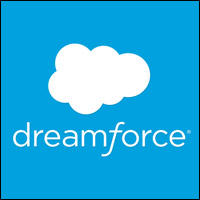With less than a week to go, Dreamforce continues to bear down on the world like a hurricane slowly approaching from across the ocean — in a good way, if that makes any sense. Salesforce has pumped new products into the market that will serve as the focus of at least part of the discussion in San Francisco. Also, CEO and Chairman Marc Benioff recently decided to buy Time magazine, one of journalism’s 20th century icons.
Over the late summer, the company introduced improvements or whole new products for the small and mid-sized business market, philanthropy and financial services. There is a theme in this, but it might be hard to suss out.
To save time, let’s say that Salesforce continues a “hit ’em where they ain’t” strategy, which I translate to mean that they preferentially invent net new solutions over simply paving over a well-worn cow path. This is important, because many technology companies — if not most — have made their names, and a very nice living, in the paving business.
Early enterprise software vendors made fortunes developing computer analogs for the back office — especially general ledger, accounts payable, accounts receivable, billing, enterprise resource planning and material requirements planning. It’s a long list, and all these solutions were necessary, if low-hanging fruit.
However, as a second- or third-generation entrant in the enterprise space, Salesforce has more than once confounded the experts, steadfastly refusing to play to type by reinventing that wheel.
Third-Party Strategy
Many years ago, Marc Benioff made a definitive statement that Salesforce would not build an ERP system. Many in the chattering class regarded that as either heresy or silly. There were many arguments for building a front-to-back office solution that many thought would eliminate a lot of the integration and deployment issues plaguing the industry.
Oracle tried to dominate with a suite strategy that was only partly successful. Even then, Salesforce’s strategy was to encourage third parties to do the work, to build apps on its platform, and new companies in the shadow of the AppExchange. The results have been impressive.
Today there’s no shortage of finance applications from vendors like FinancialForce or Intacct in the AppExchange. Additionally, many NetSuite customers are also Salesforce customers, proving the strategies of both companies to offer the best possible integration tools.
Salesforce has maintained a course that brings new applications and app categories to market. In healthcare, for instance, the company has developed a badly needed system of engagement that melds data from ancient hospital management, lab, and insurance systems to produce an information resource that practitioners can leverage.
It’s better by far than a paper chart and gives a caretaker the information needed to provide care. In banking, insurance and finance, Salesforce has, with partners including nCino and Vlocity, delivered more systems of engagement to help these industries deal with customers who are far wealthier than prior generations and need help.
What’s Next?
Salesforce continues to claim new territory too. It has built up what it calls a “collaboration suite” around the acquisition of Quip. Introduced this week, Quip Slides is part of an ongoing effort to challenge Microsoft Office’s dominance by leveraging front office data and documents.
Salesforce recently added to its Financial Services Cloud, still working with partners but also lending its own expertise.
It has expanded its offerings for the SMB market too, carving out a small-to-large business growth path for emerging companies that don’t want to overbuy technology and don’t want to have a laborious conversion later.
Finally, there’s the Philanthropy Cloud, technically a product of Salesforce.org, the nonprofit part of the business. This cloud gives any business the ability to show credibility in community service without breaking the bank. The cloud automates most of the tedious work that many nonprofits and donor organizations still do by hand because there are few affordable and comprehensive systems.
So it turns out that the real genius of Salesforce wasn’t just being first to the cloud. That was important early on, but you can further distill that move as being future-oriented, of asking what’s next and striving to deliver it.
It puts me in mind of something George Bernard Shaw once said that Bobby Kennedy adopted in 1968. Shaw said, “There are those that look at things the way they are, and ask why? I dream of things that never were, and ask why not?”
If you want to understand what’s special about Dreamforce, it’s that tens of thousands of people go there to ask why not.


























































Social Media
See all Social Media